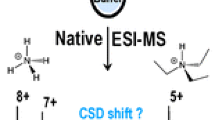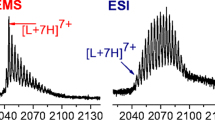Abstract
Positive ion mode of electrospray ionization mass spectrometry (ESI-MS) has been used for the detection and study of protein interaction. From the measurement of molecular mass of the intact complex and individual binding partners, the binding stoichiometry can be derived. In our work, one basic protein, hen egg white lysozyme (HEWL) as an anion receptor shows high sensitivity and selectivity responses to most oxoanions detected by ESI-MS. But neutral protein, such as insulin, does not response to anions. It was found that HSO4 -, IO4 -, ClO4 -, H2PO4 -, HCO3 - and AcO- have strong affinity to interact with HEWL under present condition, butHSO3 -, NO3 -, Cl- and F- could not be trapped by HEWL. ESI-MS condition and concentration of anions areconsidered. This is an important evidence obtained by mass spectrometryfor the distribution of anion recognition with a native protein.
Similar content being viewed by others
References
Sessler, J.L. and Davis, J.M., Sapphyrins: Versatile anion binding agents. Acc. Chem. Res., 34 (2001) 989.
Miyaji, H., Sato, W. and Seeler, J.L., Naked-eye detection of anions in dichloromethane: Colorimetric anion sensors based on calix pyrrole. Angew. Chem., 39 (2000) 1777.
Wu, F.Y., Li, Zh., Wen, Zh. Ch., Zh, N., Zhao,Y.F. and Jiang, Y.B., A novel thiourea-based dual fluorescent anion receptor with a rigid hydrazine spacer. Organic Lett., 19 (2002) 3203.
Sasaki, Shin-ichi, Ozawa, Satoru, Citterio, Daniel, Iwasawa, Naoko and Suzuki, Koji, Phosphate anion sensing based on preorganized tripodal ionophores. Anal. Sciences, 17 (2001) i1659.
Loo, J.A., Studying noncovalent protein complexes by elec-trospray ionization mass spectrometry. Mass Spectrom. Rev., 16 (1997) 1.
Loo, J.A., Probing protein-metal ion interactions by electros-pray ionisation mass spectrometry: Enolase and nucleocapsid protein. Int. J. Mass Spectrom., 204 (2001) 113.
Berman, H.M., Westbrook, J., Feng, Z., Gilliland, G., Bhat, T.N., Weissig, H., Shindyalov, I.N. and Bourne, P.E., The protein data bank. Nucl. Acids Resear., 28 (2000) 235.
Grandori, Rita, Origin of the conformation dependence of pro-tein charge-state distributions in electrospray ionization mass spectrometry, J. Mass Spectrom., 38 (2003) 11.
Author information
Authors and Affiliations
Corresponding author
Rights and permissions
About this article
Cite this article
Yang, L., Yu, L., Liu, Y. et al. Direct observation of basic protein HEWL as an oxoanions receptor by electrospray ionization mass spectrometry. Letters in Peptide Science 10, 89–92 (2003). https://doi.org/10.1023/B:LIPS.0000032368.82164.a5
Issue Date:
DOI: https://doi.org/10.1023/B:LIPS.0000032368.82164.a5




